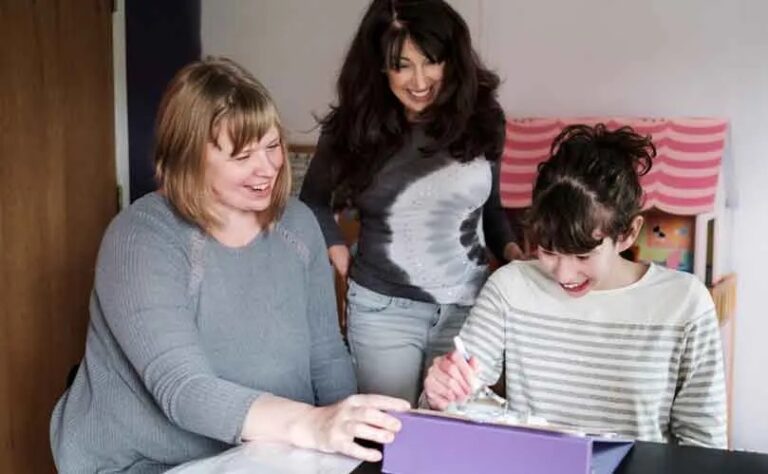Author’s note: For several years, I worked with children with autism and their families all over the United States, providing ABA therapy.
I hope my experience as a Registered Behavior Technician will help you answer your questions about autism!
So, your family member just received an autism diagnosis, or perhaps you’re waiting for the results of autism testing and are fairly certain of the outcome. What do you do after you find out your child has autism?
You’re probably feeling a mix of things: concern, confusion, shock, maybe even relief. No book or provider can prepare a parent for when they learn their family will be changed by autism. The experience of processing the news is unique to the parent but will transform the whole family.
However long the journey may seem, the beginning starts with one simple step: acceptance.
In the case of an autism diagnosis, many studies show that early intervention (getting treatment for a child as early as 18 months old) is key. It’s important to start services as soon as you receive a diagnosis.
The evidence-based practices of ABA (Applied Behavior Analysis) therapy will help you and your child gain insight into skill development and, most importantly, independence. A few examples include:
- Working with a Board Certified Behavior Analyst (BCBA) on what behaviors you are observing and what treatment goals you’d like to set
- Having a Registered Behavior Technician (RBT) providing ABA therapy in-home or at a center for several hours weekly
- Signing off on behavior-based treatment plans
As you fill your Amazon cart with books about Autism Spectrum Disorder (ASD) and slowly turn your home into a stimulating yet soothing environment for your neurodivergent loved one, here are a few things to keep in mind:
- Your parenting style may differ from that of parents around you raising neurotypical children or even neurodivergent children.
- Your child may act and learn differently than children without a developmental disability. These seemingly radical truths may be hard at first, yet they can be the most freeing part of the process.
- The future for your child and family may look different than you thought it would. Your family has new needs that you must accommodate.
- Accept that autism is lifelong; your child will not outgrow the diagnosis.
With all that said, there are things you can do to help children with autism thrive. You can support their growth and nurture their talents in so many ways. You can also learn a lot about how to care for yourself in the process.
1. Don’t wait for an official diagnosis to contact treatment providers
If your child exhibits developmental delays, reach out to a provider and become familiar with resources on childhood development. Talk to your pediatrician and seek a consultation with a Board Certified Behavior Analyst. These professionals are trained in behavior and development and can offer more insight into what is happening.
2. Educate yourself on ASD, symptoms, behaviors, and effective, evidence-based treatments
Learn what works and what doesn’t when it comes to treatments. Learn about the experience of a child with autism. As your child’s support system, you are their best advocate. This will be especially important if your child is nonverbal or scripting (repeating words over and over).
3. Remind yourself that every behavior serves a function
Whether your child watches the same video every day at a particular time, flails their hands wildly when excited, or recites scripted movie lines in response to verbal cues, these behaviors serve some kind of function; there is a reason why they happen. BCBAs can help you find the function of behaviors and create goals to develop more appropriate behaviors.
4. You are the expert on your child
You are your child’s biggest advocate, expert, and cheerleader. Throw yourself into understanding what the world is like for your child with ASD. Participating in sessions with your RBT (Registered Behavior Technician) is a great way to do this. Ask questions, read blogs, and observe your child’s behavior patterns.
Make sure to be an expert on you as well! Schedule time for self-care. The best way to help your child is to ensure you are also helping yourself.
5. Provide safety and structure
Structure and consistency are helpful for children with ASD. Carefully explain things to your child before they happen so nothing comes as a big surprise. Also, try to be mindful of the noise, light, and crowding level at any event you attend. Believe it or not, you may learn to prevent your child from being triggered at any time.
6. Reward good behavior
When your child does something good, reward them! Sitting quietly or patiently waiting? Reward. Trying new foods? Reward. Using their words to describe their experience? Reward.
A huge part of ABA is rewarding desirable behavior. You want to let the child know immediately that what they are doing is what you want to see more of. By associating good behavior with a positive outcome, we increase the likelihood that the child will repeat that behavior. One method for this reward system is to designate a basket of toys used only for rewarding good behavior. Include glitter, stickers, special snacks, toy cars, and other things you know your child will enjoy! However, ONLY use these items for rewards. The idea is that these rewards remain special and are not easily accessible.
7. Make your home a haven for your loved one with ASD
Although this may sound obvious, consider your child’s needs when decorating your home. For example, if your child is inclined to put things in their mouth, take them out of the room. If your child is inclined to spin or drop to the ground, place a soft rug in an acceptable place to spin. Accommodate your child’s needs while keeping their safety in your mind.
8. Look for nonverbal cues
Start observing your child’s body and look for signs that they may not feel okay. Look for sounds, gestures, facial expressions, and body language that may precede undesirable behavior. Start to read these signs before a meltdown to avoid further agitation.
9. Make time for fun
Receiving an autism diagnosis can be difficult for a family. But it can also be like learning the secret recipe to the world’s best sauce! It takes time, but you can create something special when you finally figure out what works! Set aside time for fun. This can relieve pressure and bring a family closer together.
If your child or loved one is on the autism spectrum and in need of treatment, or maybe you’re seeking autism testing, it’s a good idea to schedule a meeting with a BCBA to see if ABA therapy sessions are the best help for your child and family. Whether you need full ABA therapy sessions or a few meetings for parent-training services, meeting with a knowledgeable BCBA can help you determine the best way to help a person with autism develop appropriate behaviors and expressions of feelings.
Contact us for a free consultation about ABA therapy at our treatment centers or in-home services, or call 844-923-4222.







